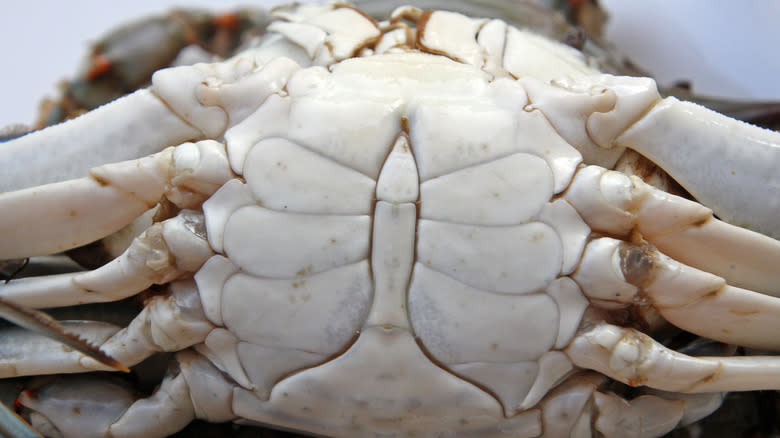Why You Should Never Eat Crab Lungs

Known for their sweet and slightly briny meat underneath the thick, chitinous shell, crabs — whatever method you use to cook them — are one of the best kinds of seafood you can table. People often try to get every bit of delicious crab meat they can, given how good it tastes and, of course, because quality crabs like snow crabs and king crabs don't come cheap!
Thankfully, nearly every part of a crab is edible, with one exception: The lungs, also known as the gills. These feathery, cone-shaped parts line the outer edges of the crab's shell. While they've inspired stories and tales, none of them paint a flattering picture by giving them unflattering names like "dead man's fingers" or "devil's fingers," rumoring that they might be harmful to eat. But that's just a myth. To set the record straight, crab gills are not inherently toxic, provided you cook and boil the crab properly.
The gills do tend to contain higher levels of heavy metals, which makes avoiding them a sound decision. But outside of the science, there's a far more compelling reason to skip this part of the crab: They simply don't taste good. Crab gills are tough and chewy, with a bitter flavor that no amount of seasoning can improve. You're not missing out on much of the crab's lean protein content if you skip out on the lungs, either, since they're made mostly out of chitin, or the same material as the crab's shell.
Read more: 15 Different Ways To Cook Fish
Other Parts Of A Crab You Should Avoid Eating

In addition to the obvious parts like the tough outer shell and the apron (the hard belly under the crab), there are a few other parts you should steer clear of. Firstly, there are the guts, which can be found in creamy "bundles" tucked away in a small cavity between the gills near the crab's mouth. You can gently scrape them off with a knife. As an alternative, you can also rinse them away under running water. We don't recommend this method, though, since rinsing might also wash away some of the crab's delicious essences!
Crab guts are generally not harmful. However, if the crabs have been feasting on toxic algae, there could be traces of domoic acid within their digestive tracts, which can lead to poisoning. If you're unsure about the crab's source, it's safest to skip this part.
Another part you might want to think twice about, especially if you're health-conscious, is the tomalley, often referred to as "crab fat" or "crab mustard." This rich, golden substance inside the crab is considered a delicacy in many cuisines. However, it might contain traces of toxins, metals, and polychlorinated biphenyls (PCBs), which can accumulate in your body if consumed in large quantities. If you're determined to enjoy tomalley, it's recommended not to consume it from more than two crabs in a single day, according to the Agency for Toxic Substances and Disease Registry. Use your discretion when deciding whether to indulge!
Read the original article on Tasting Table.